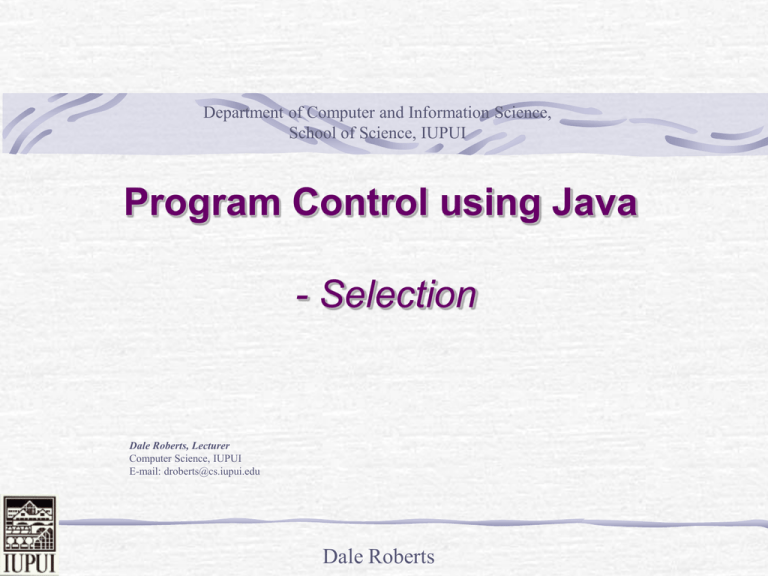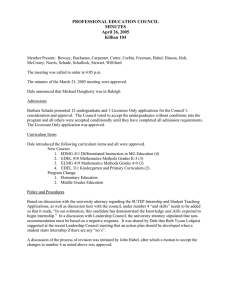Program Control using Java - Selection Dale Roberts
advertisement

Department of Computer and Information Science,
School of Science, IUPUI
Program Control using Java
- Selection
Dale Roberts, Lecturer
Computer Science, IUPUI
E-mail: droberts@cs.iupui.edu
Dale Roberts
4.4 Control Structures (Cont.)
Selection Statements
if statement
Single-selection statement
if…else statement
Double-selection statement
switch statement
Multiple-selection statement
2
Dale Roberts
4.5 if Single-Selection Statement
if statements
Execute an action if the specified condition is true
Can be represented by a decision symbol (diamond) in a
UML activity diagram
Transition arrows out of a decision symbol have guard conditions
Workflow follows the transition arrow whose guard condition
is true
3
Dale Roberts
Fig. 4.2
4
|
if
single-selection statement
UML activity diagram.
Dale Roberts
4.6 if…else Double-Selection Statement
if…else statement
Executes one action if the specified condition is true or a
different action if the specified condition is false
Conditional Operator ( ? : )
Java’s only ternary operator (takes three operands)
? : and its three operands form a conditional expression
Entire conditional expression evaluates to the second operand if
the first operand is true
Entire conditional expression evaluates to the third operand if the
first operand is false
5
Dale Roberts
| …else double-selection
statement UML activity diagram.
Fig. 4.3
6
if
Dale Roberts
|
multiple-selection
statement UML activity
diagram with
statements.
Fig. 5.11
switch
break
7
Dale Roberts
Software Engineering Observation 5.2
Provide a default case in switch
statements. Including a default case
focuses you on the need to process
exceptional conditions.
8
Dale Roberts
1
2
3
4
5
6
7
8
9
10
11
12
13
14
15
16
17
18
19
20
21
22
23
24
25
26
27
28
// Fig. 5.9: GradeBook.java
// GradeBook class uses switch statement to count A, B, C, D and F grades.
import java.util.Scanner; // program uses class Scanner
public class GradeBook
{
private String courseName; // name of course this GradeBook represents
private int total; // sum of grades
private int gradeCounter; // number of grades entered
private int aCount; // count of A grades
private int bCount; // count of B grades
private int cCount; // count of C grades
private int dCount; // count of D grades
private int fCount; // count of F grades
// constructor initializes courseName;
// int instance variables are initialized to 0 by default
public GradeBook( String name )
{
courseName = name; // initializes courseName
} // end constructor
// method to set the course name
public void setCourseName( String name )
{
courseName = name; // store the course name
} // end method setCourseName
Dale Roberts
Outline
GradeBook.j
ava
(1 of 5)
Lines 8-14
9
29
// method to retrieve the course name
30
public String getCourseName()
31
{
32
33
return courseName;
} // end method getCourseName
34
35
36
37
38
39
40
// display a welcome message to the GradeBook user
public void displayMessage()
{
// getCourseName gets the name of the course
System.out.printf( "Welcome to the grade book for\n%s!\n\n",
getCourseName() );
GradeBook.j
ava
(2 of 5)
41
42
43
} // end method displayMessage
Lines 50-54
44
45
public void inputGrades()
{
46
47
48
49
50
51
52
53
54
Outline
10
// input arbitrary number of grades from user
Scanner input = new Scanner( System.in );
Display prompt
int grade; // grade entered by user
System.out.printf( "%s\n%s\n
%s\n
%s\n",
"Enter the integer grades in the range 0-100.",
"Type the end-of-file indicator to terminate input:",
"On UNIX/Linux/Mac OS X type <ctrl> d then press Enter",
"On Windows type <ctrl> z then press Enter" );
55
Dale Roberts
56
57
58
59
60
61
62
63
64
65
66
67
68
69
70
71
72
73
74
75
76
77
78
79
80
81
82
// loop until user enters the end-of-file indicator
while ( input.hasNext() )
{
grade = input.nextInt(); // read grade
total += grade; // add grade to total Loop condition uses method hasNext to
++gradeCounter; // increment numberdetermine
of grades whether there is more data to input
Outline
// call method to increment appropriate counter
incrementLetterGradeCounter( grade );
} // end while
} // end method inputGrades
// add 1 to appropriate counter for specified grade
public void incrementLetterGradeCounter( int numericGrade )
{
(grade / 10 ) is controlling
// determine which grade was entered
switch ( grade / 10 )
expression
{
case 9: // grade was between 90
switch statement determines which
case 10: // and 100
case label to execute, depending on
++aCount; // increment aCount
controlling expression
break; // necessary to exit switch
case 8: // grade was between 80 and 89
++bCount; // increment bCount
break; // exit switch
Dale Roberts
11
GradeBook.j
ava
(3 of 5)
Line 57
Line 72
controlling
expression
Lines 72-94
case 7: // grade was between 70 and 79
83
Outline
++cCount; // increment cCount
break; // exit switch
84
85
86
87
12
case 6: // grade was between 60 and 69
++dCount; // increment dCount
break; // exit switch
88
89
90
91
92
GradeBook.j
ava
(4 of 5)
default: // grade was less than 60
++fCount; // increment fCount
break; // optional; will exit switch anyway
93
94
95
} // end switch
default case for grade
} // end method incrementLetterGradeCounter
96
97
98
// display a report based on the grades entered by user
public void displayGradeReport()
99
{
100
101
102
System.out.println( "\nGrade Report:" );
103
104
if ( gradeCounter != 0 )
{
105
106
less than 60
// if user entered at least one grade...
// calculate average of all grades entered
double average = (double) total / gradeCounter;
107
Dale Roberts
Line 91 default
case
108
// output summary of results
109
System.out.printf( "Total of the %d grades entered is %d\n",
110
gradeCounter, total );
111
System.out.printf( "Class average is %.2f\n", average );
112
System.out.printf( "%s\n%s%d\n%s%d\n%s%d\n%s%d\n%s%d\n",
113
"Number of students who received each grade:",
114
"A: ", aCount,
// display number of A grades
115
"B: ", bCount,
// display number of B grades
116
"C: ", cCount,
// display number of C grades
117
"D: ", dCount,
// display number of D grades
118
"F: ", fCount ); // display number of F grades
119
} // end if
120
else // no grades were entered, so output appropriate message
121
122
System.out.println( "No grades were entered" );
} // end method displayGradeReport
123 } // end class GradeBook
Dale Roberts
Outline
13
GradeBook.j
ava
(5 of 5)
1
// Fig. 5.10: GradeBookTest.java
2
3
4
// Create GradeBook object, input grades and display grade report.
5
{
6
7
8
Outline
14
public class GradeBookTest
public static void main( String args[] )
{
// create GradeBook object myGradeBook and
Call GradeBook public
methods to count grades
9
10
11
// pass course name to constructor
GradeBook myGradeBook = new GradeBook(
"CS101 Introduction to Java Programming" );
12
13
14
myGradeBook.displayMessage(); // display welcome message
myGradeBook.inputGrades(); // read grades from user
15
myGradeBook.displayGradeReport(); // display report based on grades
16
} // end main
17 } // end class GradeBookTest
Dale Roberts
GradeBookT
est.java
(1 of 2)
Lines 13-15
Outline
Welcome to the grade book for
CS101 Introduction to Java Programming!
15
Enter the integer grades in the range 0-100.
Type the end-of-file indicator to terminate input:
On UNIX/Linux/Mac OS X type <ctrl> d then press Enter
On Windows type <ctrl> z then press Enter
99
92
45
57
63
71
76
85
90
100
^Z
Grade Report:
Total of the 10 grades entered is 778
Class average is 77.80
Number of students who received each grade:
A: 4
B: 1
C: 2
D: 1
F: 2
Dale Roberts
GradeBookT
est.java
(2 of 2)
Program output
Portability Tip 5.1
The keystroke combinations for
entering end-of-file are system
dependent.
16
Dale Roberts
Good Programming Practice 5.8
Although each case and the default case
in a switch can occur in any order, place
the default case last. When the default
case is listed last, the break for that case
is not required. Some programmers
include this break for clarity and symmetry
with other cases.
17
Dale Roberts
switch Multiple-Selection Statement (Cont.)
Expression in each case
Constant integral expression
Combination of integer constants that evaluates to a constant
integer value
Character constant
E.g., ‘A’, ‘7’ or ‘$’
Constant variable
Declared with keyword final
18
Dale Roberts
5.7 break and continue Statements
break/continue
Alter flow of control
break statement
Causes immediate exit from control structure
Used in while, for, do…while or switch statements
continue statement
Skips remaining statements in loop body
Proceeds to next iteration
Used in while, for or do…while statements
19
Dale Roberts
Common Programming Error 5.7
Forgetting a break statement when one
is needed in a switch is a logic error.
20
Dale Roberts
1
2
3
4
5
6
7
8
9
10
11
12
13
14
15
16
17
18
19
// Fig. 5.12: BreakTest.java
// break statement exiting a for statement.
public class BreakTest
{
public static void main( String args[] )
Loop 10 times
{
int count; // control variable also used after
Exitloop
forterminates
statement
(break)
when count equals 5
for ( count = 1; count <= 10; count++ ) // loop 10 times
{
if ( count == 5 ) // if count is 5,
break;
// terminate loop
Outline
21
BreakTest.ja
va
Line 9
Lines 11-12
System.out.printf( "%d ", count );
} // end for
System.out.printf( "\nBroke out of loop at count = %d\n", count );
} // end main
} // end class BreakTest
1 2 3 4
Broke out of loop at count = 5
Dale Roberts
Program
output
1
// Fig. 5.13: ContinueTest.java
2
// continue statement terminating an iteration of a for statement.
3
4
5
public class ContinueTest
{
public static void main( String args[] )
6
7
8
9
10
22
Loop 10 times
{
and proceed to
for ( int count = 1; count <= 10; count++ ) //Skip
loopline
10 12
times
{
line 7 when count equals 5
if ( count == 5 ) // if count is 5,
continue;
// skip remaining code in loop
11
12
13
14
Outline
System.out.printf( "%d ", count );
} // end for
15
System.out.println( "\nUsed continue to skip printing 5" );
16
} // end main
17 } // end class ContinueTest
1 2 3 4 6 7 8 9 10
Used continue to skip printing 5
Dale Roberts
ContinueTe
st.java
Line 7
Lines 9-10
Program
output
Software Engineering Observation 5.3
Some programmers feel that break and
continue violate structured
programming. Since the same effects
are achievable with structured
programming techniques, these
programmers do not use break or
continue.
23
Dale Roberts
Software Engineering Observation 5.4
There is a tension between achieving
quality software engineering and
achieving the best-performing software.
Often, one of these goals is achieved at
the expense of the other. For all but the
most performance-intensive situations,
apply the following rule of thumb: First,
make your code simple and correct; then
make it fast and small, but only if
necessary.
24
Dale Roberts
Acknowledgements
Deitel, Java How to Program
Dale Roberts



